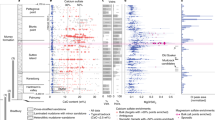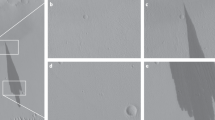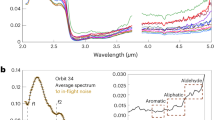Abstract
Determining whether liquid water exists on the Martian surface is central to understanding the hydrologic cycle and potential for extant life on Mars. Recurring slope lineae, narrow streaks of low reflectance compared to the surrounding terrain, appear and grow incrementally in the downslope direction during warm seasons when temperatures reach about 250–300 K, a pattern consistent with the transient flow of a volatile species1,2,3. Brine flows (or seeps) have been proposed to explain the formation of recurring slope lineae1,2,3, yet no direct evidence for either liquid water or hydrated salts has been found4. Here we analyse spectral data from the Compact Reconnaissance Imaging Spectrometer for Mars instrument onboard the Mars Reconnaissance Orbiter from four different locations where recurring slope lineae are present. We find evidence for hydrated salts at all four locations in the seasons when recurring slope lineae are most extensive, which suggests that the source of hydration is recurring slope lineae activity. The hydrated salts most consistent with the spectral absorption features we detect are magnesium perchlorate, magnesium chlorate and sodium perchlorate. Our findings strongly support the hypothesis that recurring slope lineae form as a result of contemporary water activity on Mars.
This is a preview of subscription content, access via your institution
Access options
Subscribe to this journal
Receive 12 print issues and online access
$259.00 per year
only $21.58 per issue
Buy this article
- Purchase on Springer Link
- Instant access to full article PDF
Prices may be subject to local taxes which are calculated during checkout




Similar content being viewed by others
Change history
14 October 2015
In the version of this Letter originally published, the journal name in ref. 12 was incorrect, it should have been Nature Geoscience. This has been corrected in all versions of the Letter.
References
McEwen, A. S. et al. Seasonal flows on warm Martian slopes. Science 333, 740–743 (2011).
McEwen, A. S. et al. Recurring slope lineae in equatorial regions of Mars. Nature Geosci. 7, 53–58 (2014).
Ojha, L. et al. HiRISE observations of recurring slope lineae (RSL) during southern summer on Mars. Icarus 231, 365–376 (2014).
Ojha, L. et al. Spectral constraints on the formation mechanism of recurring slope lineae. Geophys. Res. Lett. 40, 5621–5626 (2013).
Hecht, M. H. et al. Detection of perchlorate and the soluble chemistry of martian soil at the Phoenix lander site. Science 325, 64–67 (2009).
Glavin, D. P. et al. Evidence for perchlorates and the origin of chlorinated hydrocarbons detected by SAM at the Rocknest aeolian deposit in Gale Crater. J. Geophys. Res. 118, 1955–1973 (2013).
Ehlmann, B. L. & Edwards, C. S. Mineralogy of the Martian surface. Annu. Rev. Earth Planet. Sci. 42, 291–315 (2015).
Pestova, O. N., Myund, L. A., Khripun, M. K. & Prigaro, A. V. Polythermal study of the systems M(ClO4)2-H2O (M2+ = Mg2+, Ca2+, Sr2+, Ba2+). Russ. J. Appl. Chem. 78, 409–413 (2005).
Chevrier, V. F., Hanley, J. & Altheide, T. S. Stability of perchlorate hydrates and their liquid solutions at the Phoenix landing site, Mars. Geophys. Res. Lett. 36, L10202 (2009).
Hanley, J., Chevrier, V. F., Berget, D. J. & Adams, R. D. Chlorate salts and solutions on Mars. Geophys. Res. Lett. 39, L08201 (2012).
Altheide, T., Cheverier, V. F., Nicholson, C. & Denson, J. Experimental investigation of the stability and evaporation of sulfate and chloride brines on Mars. Earth Planet. Sci. Lett. 282, 69–78 (2009).
Martín-Torres, F. J. et al. Transient liquid water and water activity at Gale crater on Mars. Nature Geosci. 8, 357–361 (2015).
McEwen, A. S. et al. Mars Reconnaissance Orbiter’s High Resolution Imaging Science Experiment (HiRISE). J. Geophys. Res. 112, 1991–2012 (2007).
Murchie, S. et al. Compact Reconnaissance Imaging Spectrometer for Mars (CRISM) on Mars Reconnaissance Orbiter (MRO). J. Geophys. Res. 112, 1–57 (2007).
Clark, R. N. in Manual of Remote Sensing, Volume 3, Remote Sensing for the Earth Sciences (ed. Rencz, A. N.) 3–58 (John Wiley, 1999).
Massé, M. et al. Spectroscopy and detectability of liquid brines on Mars. Planet. Space Sci. 92, 136–149 (2014).
Hanley, J. et al. Reflectance spectra of hydrated chlorine salts: The effect of temperature with implications for Europa. J. Geophys. Res. 119, 2370–2377 (2014).
Bishop, J. L., Quinn, R. & Darby, D. M. Spectral and thermal properties of perchlorate salts and implications for Mars. Am. Mineral. 99, 1580–1592 (2014).
Rummel, J. D. et al. A new analysis of Mars “Special Regions”: Findings of the Second MEPAG Special Regions Science Analysis Group (SR-SAG2). Astrobiology 14, 887–968 (2014).
Cull, S. C. et al. Concentrated perchlorate at the Mars Phoenix landing site: Evidence for thin film liquid water on Mars. Geophys. Res. Lett. 37, L22203 (2010).
Navarro-Gonzalez, R., Vargas, E., Rosa, J., Raga, A. C. & McKay, C. P. Reanalysis of the Viking results suggests perchlorate and organics at midlatitudes on Mars. J. Geophys. Res. 115, E12010 (2010).
Elsenousy, A., Hanley, J. & Chevrier, V. F. Effect of evaporation and freezing on the salt paragenesis and habitability of brines at the Phoenix landing site. Earth Planet. Sci. Lett. 421, 39–46 (2015).
Kounaves, S., Carrier, B. L., O’Neil, G. D., Stroble, S. T. & Claire, M. W. Evidence of Martian perchlorate, chlorate and nitrate in Mars meteorite EETA79001: Implications for oxidants and organics. Icarus 229, 206–213 (2014).
Chevrier, V. F. & Rivera-Valentin, E. G. Formation of recurring slope lineae by liquid brines on present-day Mars. Geophys. Res. Lett. 39, L21202 (2012).
Davila, A. F. et al. Facilitation of endolithic microbial survival in the hyperarid core of the Atacama Desert by mineral deliquescence. J. Geophys. Res. 113, 2005–2012 (2008).
Davila, A. F., Hawes, I., Ascaso, C. & Wierzchos, J. Salt deliquescence drives photosynthesis in the hyperarid Atacama Desert. Environ. Microbiol. Rep. 5, 583–587 (2013).
Aharon, O., Bardavid, R. E. & Mana, L. Perchlorate and halophilic prokaryotes: Implications for possible halophilic life on Mars. Extremophiles 18, 75–80 (2014).
Hanley, J., Chevrier, V. F., Barrows, R. S., Swaffer, C. & Altheide, T. S. Near- and mid-infrared reflectance spectra of hydrated oxychlorine salts with implications for Mars. J. Geophys. Res. 120, 1415–1426 (2015).
Crowley, J. K. Visible and near-infrared (0.4–2.5 μm) reflectance spectra of Playa evaporite minerals. J. Geophys. Res. 96, 16231–16240 (1991).
Acknowledgements
L.O. and M.B.W. are funded by the National Science Foundation Graduate Research Fellowship Program under Grant No. DGE-1148903. The research was further supported by MDAP Grant No. NNX13AK01G. All original data described in this paper are reported in the SOM and archived by NASA’s Planetary Data System. We thank the MRO science and engineering team for returning such an incredible data set. The paper benefited from initial reviews by B. Schmidt and L. Liuzzo.
Author information
Authors and Affiliations
Contributions
The methodology was conceived and designed by L.O. All data analysis was done by L.O. with significant feedback from S.L.M., J.J.W., A.S.M. and M.B.W. J.J.W., M.B.W., J.H. and M.M. provided all the laboratory spectra used in this paper. A.S.M., M.C. and S.L.M. planned many of the HiRISE–CRISM coordinated observations of the RSL sites. All authors contributed to discussion, interpretation and writing.
Corresponding author
Ethics declarations
Competing interests
The authors declare no competing financial interests.
Supplementary information
Supplementary Information
Supplementary Information (PDF 3115 kb)
Rights and permissions
About this article
Cite this article
Ojha, L., Wilhelm, M., Murchie, S. et al. Spectral evidence for hydrated salts in recurring slope lineae on Mars. Nature Geosci 8, 829–832 (2015). https://doi.org/10.1038/ngeo2546
Received:
Accepted:
Published:
Issue Date:
DOI: https://doi.org/10.1038/ngeo2546
This article is cited by
-
Softness of hydrated salt crystals under deliquescence
Nature Communications (2023)
-
A possible unique ecosystem in the endoglacial hypersaline brines in Antarctica
Scientific Reports (2023)
-
Effects of Salt Precipitation in the Topmost Soil Layer Investigated by NMR
Applied Magnetic Resonance (2023)
-
Extremophile enzyme optimization for low temperature and high salinity are fundamentally incompatible
Extremophiles (2022)
-
Terrestrial Martian Analog Heritage of Kachchh Basin, Western India
Geoheritage (2022)



